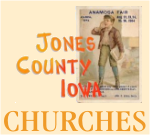
The Methodists held their first meeting in Thomas Green's barn in June, 1855, and formed a class. It was then a part of Mineral Creek Circuit, and Joel B. Taylor was the preacher in charge, and J. G. Dimmitt was the Presiding Elder. I think the latter was a sound man on some theological points. I once heard him say that "a lazy man was one of God's nuisances," and I consider that a point in theology too much neglected.
The Church has been very prosperous from its first organization, and very harmonious since the completion of its church edifice. For ten years, the meetings were held in the schoolhouse. They would all agree quite pleasantly, would talk, sing and pray with fervor, and wish for a house of worship. They were willing to give both time and money to procure a church edifice; but when location was talked, there was always trouble. On the hill, in numbers, they were the strongest. On the flat, they felt the omnipotent power of money. At one time, it was thought best to raise the subscription and let that locate the church.
Bishop Haven said that "every town has some building or structure that denotes its folly." This Methodist Church building came near proving the rule true in reference to Wyoming. It had been built for a mill, by a stock company. The war and other circumstances caused the work on the mill to be stopped when the walls were up and the roof partly on. Here it stood with its windows open, but not as now—toward Jerusalem.
Owls, doves and bats found homes in its attic. Its basement was filled with cribs of corn; but no famine made a demand for it, and part of it, at last, was fed to swine in the cellar below. Tired of its dilapidated look, the stockholders, with one or two exceptions, proffered to donate it to the Methodist society, if they would finish it for a church. The offer was accepted, the vestibule added, the Church united, and, as the result, we have this comfortable, convenient and almost elegant church. It was dedicated by the Rev. A. J. Kynett September 3, 1866.
Who the first officers of the Church were the records do not tell. J. B. Taylor, Stevenson, A. Bronson, F. Amos, H. Bradshaw, J. Scholes, J. H. Todd, H. Taylor, R. Hawn, L. Catlin, G. R. Manning, W. A. Allen, B. C. Barnes, L. Taylor, H. H. Green, W. E. McCormac and J. A. Kerr have been Pastors. No minister has died, while ministering to this Church, since its organization. Two local preachers have died, who, in the early history of the Church, did much to encourage and sustain it. They were Rev. Ansel Brainard and Rev. Thomas Bronson. Both had long been identified with the Church, were ripe in years and rich in faith.






